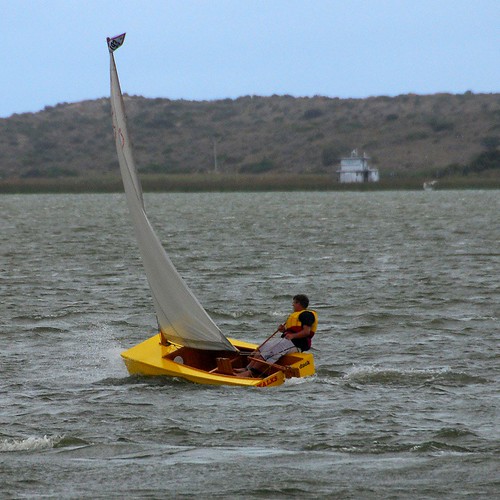OZ Goose cheap but good sailboat plan info
Truth, Beauty … what defines our complex idea of a good looking boat – perhaps our long history of rounded hulls prioritises curves and slender forms has made us to favour that type, or is our idea of beauty broader than that – is it a matter of culture?
“If it looks right, it will sail right” falls apart – OzGoose and OzRacer
This is one reply I wrote
One of the really exciting things about sailing an Oz Goose or OzRacer is the way it does your head in.
When I designed the two OZ Mk1 Ducks (shorthand for all the 8ft versions) I was really not expecting much because of my preconceptions about the square hulls, but I was really excited that the Duck movement in general was introducing so many new sailors to the sport/pastime.
So I did the best job I could of designing an efficient version. And the big sails were an OZ joke about our tendency to develop boats that are super light with huge sails. One of our 12ft classes (and I do need to bring the Kiwis in on this too – they were at least as responsible) carries about 270 square feet of working sail then pops up a 450 square foot spinnaker downwind.
On the water they were totally surprising and have changed the way I think about boat design substantially.

The reactions of knowledgeable sailors to the rectangular OzGoose and
As long as you don’t make any really stupid mistakes in hull design, most boats will sail pretty d..n well if you get the foils and rig nicely sorted.
I’ve had guys come up to me after seeing the OzRacer sailed in high wind at the Goolwa Wooden boat Festival a couple of years ago. They say that they have sailed just about everything in the Mariner’s universe and:
they just can’t understand how such a little, funny looking boat can sail so well.
Another chap had been a member of the Amateur Yacht Research Society and a serious ocean racer and he said he couldn’t get the appearance with the performance combined in his head.

Secret – stability of the rectangular hullform allows very large sails
The main contribution the truly rectangular planform and cross section hull is a huge amount of stability – making it easy to carry quite large sails with only normal risk of capsizing (or less than normal – they rarely go over).
Just as a simple example – The Laser is 14ft long and has around 75 square feet of sail. Both the OzGoose and 8ft OzRacer use 89 square feet.
Laser – 14ft – 75 square feet
Oz Racer – 8ft – 89 square feet
And we know from a lot of experience that the OzRacer is much more stable and easy to handle than the Laser. And the Goose much easier still.
Or compare the 8ft OZ Racer with similar sized boats which tend to have between 40 and 50 square feet of sail.
Being different is interesting – but only if it has some benefits for the sailor
I would say that the appearance of the OzRacer is a essential component of the interestingness. It is so counter intuitive as few can expect such a silly
looking boat to sail so well or be any where near so capable (texas200 etc) .
It kinda proves that form never follows function – form only being a bunch of stylistic trends that are accepted by a group at one time or another.
If plywood really grew on trees, then our appreciation of “classic” design would be very different and some of the 8ft Duck lessons would have been learned a lot earlier in boating history. If flat panels grew on trees people would complain of the rounded shapes that Bolger would come up with as “functional but that they can’t stomach the strange appearance”.
So all in all these strange rectangular boats highlight how many of our assumptions about performance and capability are simply prejudice.
So the appearance of the Oz Goose and Oz Racer is due some respect and should create the question whether aesthetics relate to any functional requirement at all!
Not to mention the education value (and I am in that group too) that sometimes a gamble can puncture our preconceptions and put the rectangular platform on its way to becoming a truly hallmark boat type.